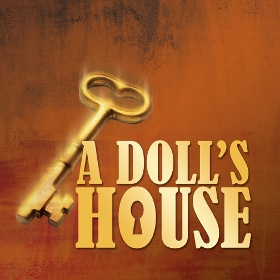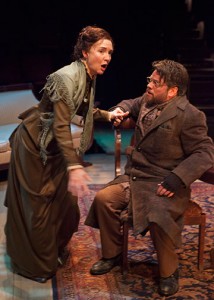NO GOOD DEED GOES UNPUNISHED
Henrik Ibsen stated that he had no conscious thought of making propaganda with A Doll’s House (1879). Yet many productions have a feminist bent: Nora is the misunderstood wife of a husband who sees her as a doll, a thing he uses to round out his modular family. As such, it has always been Nora’s story, not – as Ibsen intended – “the description of humanity.” In director Kirsten Brandt’s version (co-adapted with translator Anne-Charlotte Hanes Harvey), the oft-produced classic takes on universal themes unlike any other production I have seen. Certainly, Nora still has her wake-up call at play’s end, but this thrilling world premiere interpretation at the Old Globe concentrates on themes which will resonate with all audience members: The one mistake we seem to pay for endlessly; the roles we are unknowingly forced to play in society; the masks we wear to fit in; the complexity involved with preserving our simplistic images; and bending the law to do a good deed.
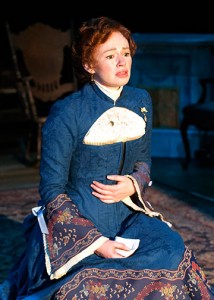 The centerpiece of this taut, suspenseful rendering is Gretchen Hall as Nora, the young wife and mother who secretly took an unlawful gamble to acquire the money necessary to save her ailing husband. Years later, as her actions threaten to bring down Nora’s family, Hall transcendently conveys panic, vulnerability and false playfulness as each new predicament she is dealt threatens to collapse the precarious house of cards in which she resides. Hall personifies her Nora as a lovely, caged songbird with clipped wings that is incapable of flying even when the cage’s door is open: She tweets and flutters manically around her parlor alternately moving toward and recoiling from the people in her life. Hall creates a ticking time-bomb atmosphere as if this were a nail-biting Frederick Knott play (Wait Until Dark, Dial M for Murder); there are times you may feel like rushing the stage to help her from the unseen monsters in her life.
The centerpiece of this taut, suspenseful rendering is Gretchen Hall as Nora, the young wife and mother who secretly took an unlawful gamble to acquire the money necessary to save her ailing husband. Years later, as her actions threaten to bring down Nora’s family, Hall transcendently conveys panic, vulnerability and false playfulness as each new predicament she is dealt threatens to collapse the precarious house of cards in which she resides. Hall personifies her Nora as a lovely, caged songbird with clipped wings that is incapable of flying even when the cage’s door is open: She tweets and flutters manically around her parlor alternately moving toward and recoiling from the people in her life. Hall creates a ticking time-bomb atmosphere as if this were a nail-biting Frederick Knott play (Wait Until Dark, Dial M for Murder); there are times you may feel like rushing the stage to help her from the unseen monsters in her life.
Her performance is aided by Alina Bokovikova’s costumes, rich in color and Norwegian propriety, Sean Fanning’s unobtrusive yet evocative set pieces, and especially David Lee Cuthbert’s lighting design, which fills the in-the-round theater 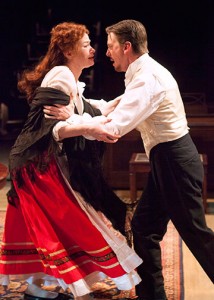 with subtle upsurges and decrescendos (miraculously, the lights do not spill on an audience which is mere feet from the performers); this is theater magic at its best when acting, directing and design seamlessly blend together like the notes which become the luscious chords of Debussy.
with subtle upsurges and decrescendos (miraculously, the lights do not spill on an audience which is mere feet from the performers); this is theater magic at its best when acting, directing and design seamlessly blend together like the notes which become the luscious chords of Debussy.
Hall’s real life husband Fred Arsenault approaches Torvald as more of a playful, finger-wagging spouse than a reprimanding boor. Filled with tenderness, decorum, politeness and gentility, Arsenault uses a motivation which lies in a need for discretion more than control. The result is a passive-aggressive calm that comes across as unintentional gaslighting. (The denouement is a bit sluggish; it was no doubt a directorial choice, but Arsenault and Hall seem inappropriately calm at play’s end.)
As Nora’s childhood friend, Kristine, a widow who arrives seeking employment, Nisi Sturgis wisely layers dignity over desperation as she becomes embroiled in the web of Nora’s deceit. Richard Baird elicits a surprising amount of empathy from the 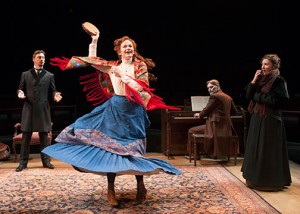 viewer as Nils Krogstad, the rapscallion who blackmails Nora so that he can secure his employment under Torvald; as such, Krogstad is at once a man to be hated and pitied – you may wish to alternately smack and comfort the distressed man.
viewer as Nils Krogstad, the rapscallion who blackmails Nora so that he can secure his employment under Torvald; as such, Krogstad is at once a man to be hated and pitied – you may wish to alternately smack and comfort the distressed man.
Ultimately, the evening belongs to Brandt’s dynamic, sensitive direction and Hall’s luminous portrayal. When intensely lyrical and sophisticated playwriting is treated with the utmost artistic insight, it becomes the apotheosis of theater, leaving us moved, touched, and inspired.
A Doll’s House
Sheryl and Harvey White Theatre
Old Globe in San Diego
scheduled to end on April 21, 2013
for tickets, call (619) 23-(GLOBE)
or visit http://www.TheOldGlobe.org
